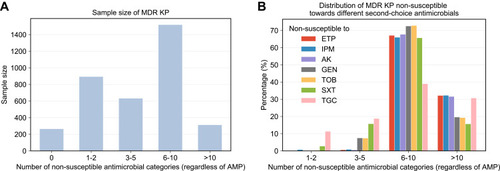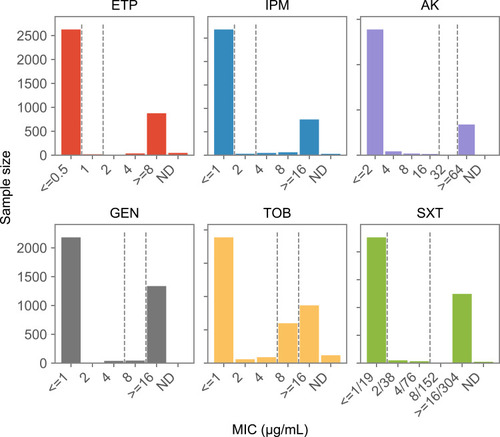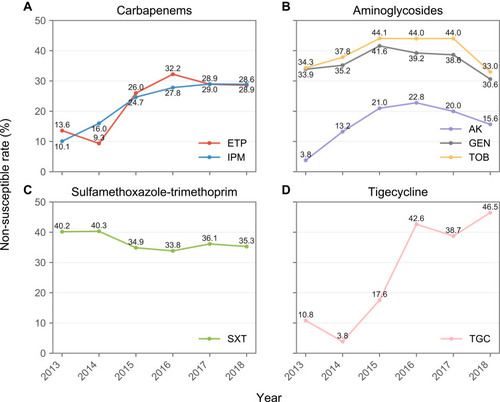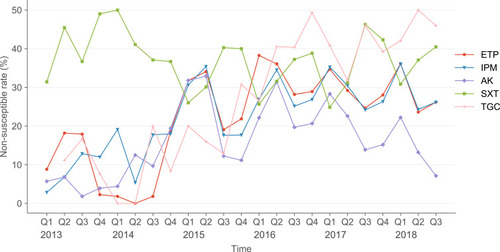Figures & data
Table 1 Clinical Characteristics of 3619 Isolates
Table 2 Sample Distribution (R%/I%/S%)a of Klebsiella pneumoniae by Year
Figure 1 Distribution of multidrug-resistance patterns among KP isolates. The sample size distribution of KP in 24 common antimicrobial agents among all 3619 analyzed isolates (A) and percentage of isolates non-susceptible to seven second-choice antimicrobials in different amount antimicrobial categories (B). MDR KP was defined as the isolates non-susceptible to three or more than three categories. As an intrinsic resistance of KP, the resistance towards AMP was excluded from this analysis.

Figure 2 Distribution of MIC for six second-choice antimicrobials. MIC distributions among isolates for six drugs: ETP, IPM, AK, GEN, TOB, and SXT. ND: data not available. CLSI 2018 breakpoints were presented as grey dashed lines in each subplot, dividing isolates into susceptible (isolates to the left of the first line), intermediate (isolates between the two lines) and resistant (isolates to the right of the second line except “ND”) types. The resistance to TGC was tested by Kirby-Bauer disk diffusion method, so there is no information on TCG MIC.

Figure 3 Dynamics in NSRs to second-choice antimicrobials from 2013 to 2018. The yearly change of NSRs to 2 carbapenems (ETP, IPM) (A), 3 aminoglycosides (AK, GEN, TOB) (B), sulfamethoxazole-trimethoprim (SXT) (C) and tigecycline (TGC) (D), between 2013 and 2018.

Table 3 Univariate Analysis of Clinical Factors for Non-Susceptibility to Second-Choice Antimicrobials
Table 4 Multivariate Analysis of Risk Factors for Non-Susceptibility to Second-Choice Antimicrobials
Figure 4 NSRs to seven second-choice antimicrobials in different departments and sample types. The Non-susceptible rates to seven second-choice antimicrobials of K. pneumoniae strains recovered from different departments (A) and different sample types (B) are presented in this figure.

Figure 5 Seasonality of non-susceptibility to five second-choice antimicrobials which showed significance in univariable and multivariable test. The non-susceptible rates to five second-choice antimicrobials between 2013 and 2018, ETP, IPM, AK, SXT presented fluctuations on a yearly basis, and the seasonality of SXT non-susceptibility was opposite to that of ETP, IPM, and AK. Different antimicrobials were presented in different colors and line styles. Q1: Jan–Mar, Q2: Apr–Jun, Q3: Jul–Sep, Q4: Oct–Dec.

Table 5 Consumption of Four Second-Choice Antimicrobials in Hospital from 2013 to 2018
